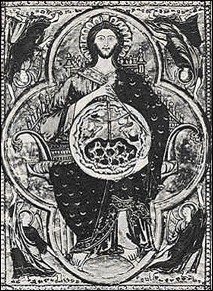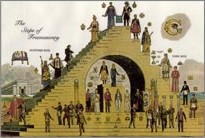| Masonry-a Family Tradition |
| History of FreeMasonry |
Albert Pike, Morals and Dogma , 1871, p. 107 "In the study of Freemasonry there are two kinds of statements which are presented to the mind of the inquiring scholar, which are sometimes concurrent, but much oftener conflicting, in their character. These are the historical and the traditional, each of which appertains to Freemasonry as we may consider it in a different aspect." Albert G. Mackey, The History of Freemasonry , 1898 A BRIEF HISTORY OF FREEMASONRY The exact beginning of the society of Freemasons is not known, but many historians, Masonic and Non-Masonic, have many theories. Some place the origins to the days of Noah's Ark , others may believe it began with the building of King Solomon's Temple , while some feel it originated with the building of the Great Pyramids in Egypt , and others trace it to King Athelston, of England in 930 ad. These are highly unlikely, but I will admit, they do make for a very colorful history. However, the most widely supported, and accepted, theory places the origin of the Fraternity to the building trade guilds of the Middle Ages.
The humble stone mason, with his common tools: the chisel, the hammer, the square, the plumb-line, and the compasses, were all he needed to create and build the magnificent edifices which have stood for centuries, and are admired by people to this day. The place where these operative craftsmen ate, slept and drew up the plans for their construction projects, was called a "lodge". And, each town, or village, that had construction crews, had these lodges of masons, carpenters, painters, etc. This term has stayed in our vocabulary to this day, what was once called a lodge of Free- Masons, is now called a Masonic Lodge. The friendship and brotherly love these men, and their families developed was an incredibly strong bond. One which was evident by the support of their fellow masons in distress, their widows and orphans. But, as the saying goes... all good things must come to an end, and there began an eventual "phasing out" of these massive construction projects. As this downsizing progressed, all the labor guilds began to lose members, and eventually discontinue all operations. However, these lodges of free masons, which had insisted on the high moral and ethical standards of its members, continued to survive. The most accepted theory, for the continuation of these groups of "Operative" Masons and their Lodges is that they started to admit new members, men who were not operative stone masons. Doctors, Farmers, Sailors, Merchants and other men, from all walks of life were allowed to join. These men, who did not really work with stones and bricks, were called "Speculative" Masons. When these Speculative members joined the Masonic Lodges, Freemasonry became more of a club or Fraternity, than a labor guild. These new members, the Speculative Masons, became accepted as equals with the Operative Masons, in a spirit of Fraternal Brotherhood, hence the "Accepted" in Free and Accepted Masons. Although, this colorful beginning of Freemasonry in not necessarily factual, nor is it provable, it only serves to lend an "air" of antiquity to the origins of this Fraternity, as there were several hundred years between the operative and speculative lodges. For instance, there are no records of operative masonic lodges in England , after 1560, nor are there any records of operative lodges in Scotland , after 1580. So for any person to say there is an actual documented connecting lineage between the two has yet to be proven to any History Scholar, Masonic or Non-Masonic. While this is the most "popular" theory, there is also some profound research which would trace the origins of Freemasonry to the original Knights Templar, who were founded in 1117. The original name of what we know as the Knights Templar was "The Poor Fellow-Soldiers of Christ and the Temple of Solomon in Jerusalem ". This is obviously a long name to be called when people are referring to this group, over time the name was modified to "The Knights of the Temple ", later it was modified even more, to the "Knights Templar". The name with which we are so familiar with today. The Knights Templar, like the Freemasons, also had three "classes" of membership in its structure. The lowest being that of Sergeant-Foot Soldier, then the highest was that of a full Brother-Knight, the third classification was that of a Cleric- Chaplain-Secretary. The job assigned to each on was well known, and the orders were given by one Grand Master of the Knights Templar who answered directly to the Pope. Where could these Knights flee to that would give them safe harbor ? The most reliable sources trace the travels of these Knights Templar to Scotland . Apparently Robert Bruce, (a/k/a Robert the Bruce), the King of Scotland, in his desire to keep his country free from outside rule, decided he did not need to read the Papal Bull ordering the arrest and execution of the Knights. Besides, if the Knights Templar wished to relocate to Scotland , they might prove useful in the battles with England , either way both groups win. The Knights Templar find safe refuge and the Scots gained a new ally. Of course in order to further conceal their identity from spies who worked for the Pope and the King of France the Knights would need to come up with new identities. The Knights Templar apparently devised a "cover-name", that of free mason, to use as the new name under which they would know themselves. Keep in mind that not all of the Knights Templar made it to Scotland , many were hiding out in other countries, and needed to find a way to regroup and to communicate with the other members. The Knights used these allegorical stories as not only to prevent their identity from being found out, but it also served as lessons in morality. The humbleness of the name of free-masons served as kind of a Knights Templar "witness relocation program", and helped to spare the lives of these humble Soldiers of Christ, the Knights of the Temple . If this theory is accurate, then it would most certainly explain the occasional references made, prior to 1717, of the Society of Freemasons. Some of the earliest writings, which allude specifically to Masonry, are the Regis Manuscript, dated in 1390, and the Cooke Manuscript, written in 1400. According to the research Lodge, Quatuor Coronati, of England , the earliest records of non- operative Masons being admitted to the Masonic Lodges took place in June of 1600. The Laird of Auchinleck, John Boswell is registered to the Lodge in Edinburgh . In 1643, there were other names added to this list. They include Lord Alexander, Sir Anthony Alexander and Sir Alexander Strachan. In 1640, General Robert Moray is entered on the roster and in 1641 General Alexander Hamilton is added. Elias Ashmole and Randle Holme were both added in 1646 and the Earl of Cassillis was registered in 1672. According to the Phililethes Society, the first native born American to be made a Mason was Jonathan Belcher, in 1704, who was then the governor of Massachusetts . Whether or not these records are proof of an earlier beginning of Fraternal Freemasonry has yet to be documented, but their being admitted to the "Society of Freemasons" sounds a lot like a Lodge of Freemasons. However, the date of June, 24th, 1717 is given as the "historically official" beginning of the Masonic Fraternity, as we know it today. This is when the United Grand Lodge of England was formed, and from which all regular Masonic Lodges, in every country, can be traced. © Copyright 1995-2000, A
Conspiracy of Hate The origins of Freemasonry are not easy to discover and scholars have spent endless hours attempting to trace its roots. On this site you will find some of the oldest known documents related to the order as well as information on significant figures in Masonic history. There are also some essays on recent discoveries. We have provided a short introduction to each of these documents below. Click on any of the links below to review these documents. Links to them are also provided at the top left of this page and the top of each page within this section of the site. |
 "Imagine not that you will
become indeed a Mason by learning what is
commonly called the "work," or
even by becoming familiar with our traditions. Masonry
has a history, a literature, a philosophy. Its
allegories and traditions will teach you
much; but much is to be sought elsewhere. The
streams of learning that now flow full and
broad must be followed to their heads in
the springs that well up in the remote past,
and you will there find the origin and the
meaning of Masonry."
"Imagine not that you will
become indeed a Mason by learning what is
commonly called the "work," or
even by becoming familiar with our traditions. Masonry
has a history, a literature, a philosophy. Its
allegories and traditions will teach you
much; but much is to be sought elsewhere. The
streams of learning that now flow full and
broad must be followed to their heads in
the springs that well up in the remote past,
and you will there find the origin and the
meaning of Masonry."  The possibility for this theory is because these
skilled craftsmen were allowed to travel from
city to city, to build the huge Cathedrals and
beautiful Castles, which now dot the European
landscape. Because of their incredible skills,
these workmen; painters, carpenters, stonemasons,
etc., were given the freedom to travel from job
site to job site, they were not owned like the
serfs and other residents of the kingdoms. It
is believed this is where the term free-mason
comes from.
The possibility for this theory is because these
skilled craftsmen were allowed to travel from
city to city, to build the huge Cathedrals and
beautiful Castles, which now dot the European
landscape. Because of their incredible skills,
these workmen; painters, carpenters, stonemasons,
etc., were given the freedom to travel from job
site to job site, they were not owned like the
serfs and other residents of the kingdoms. It
is believed this is where the term free-mason
comes from.